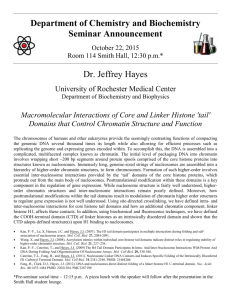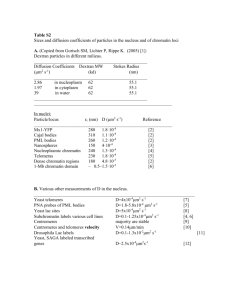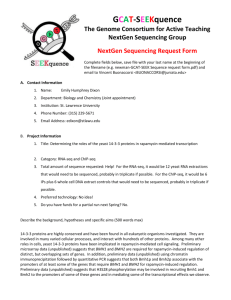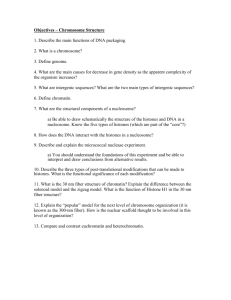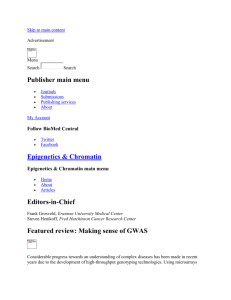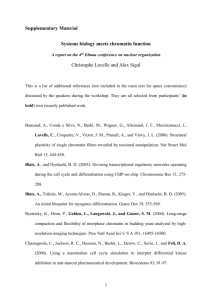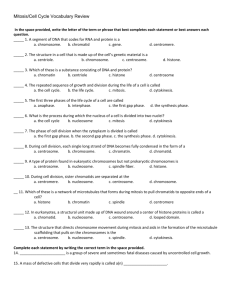Chapter 10: Chromatin and chromosomes
advertisement
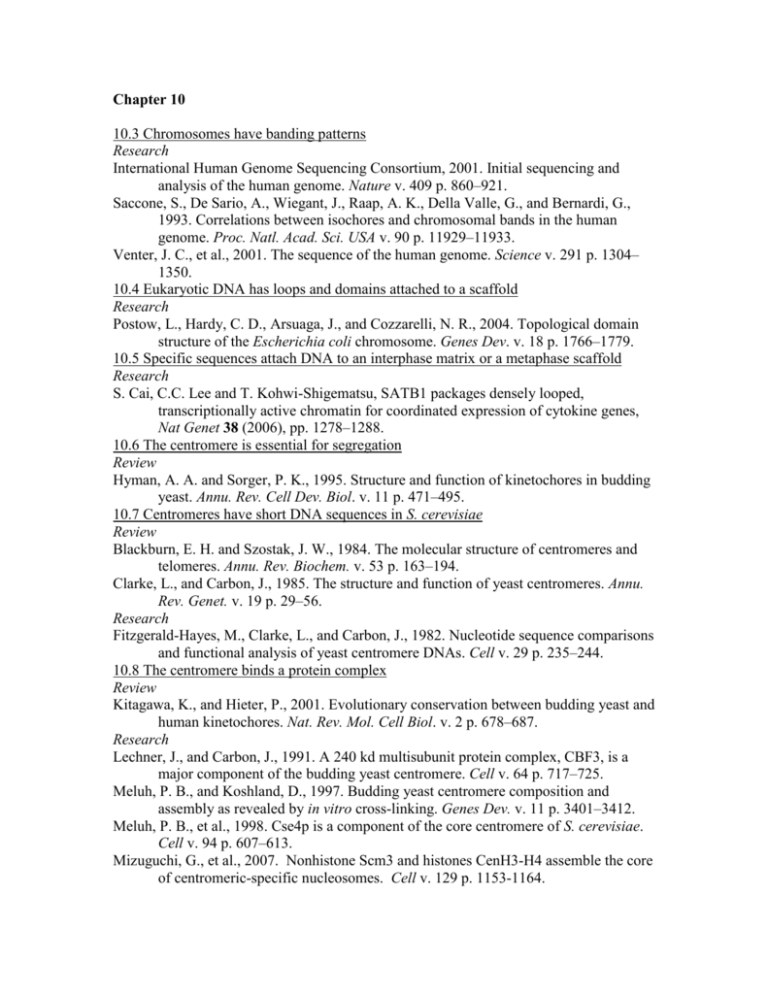
Chapter 10 10.3 Chromosomes have banding patterns Research International Human Genome Sequencing Consortium, 2001. Initial sequencing and analysis of the human genome. Nature v. 409 p. 860–921. Saccone, S., De Sario, A., Wiegant, J., Raap, A. K., Della Valle, G., and Bernardi, G., 1993. Correlations between isochores and chromosomal bands in the human genome. Proc. Natl. Acad. Sci. USA v. 90 p. 11929–11933. Venter, J. C., et al., 2001. The sequence of the human genome. Science v. 291 p. 1304– 1350. 10.4 Eukaryotic DNA has loops and domains attached to a scaffold Research Postow, L., Hardy, C. D., Arsuaga, J., and Cozzarelli, N. R., 2004. Topological domain structure of the Escherichia coli chromosome. Genes Dev. v. 18 p. 1766–1779. 10.5 Specific sequences attach DNA to an interphase matrix or a metaphase scaffold Research S. Cai, C.C. Lee and T. Kohwi-Shigematsu, SATB1 packages densely looped, transcriptionally active chromatin for coordinated expression of cytokine genes, Nat Genet 38 (2006), pp. 1278–1288. 10.6 The centromere is essential for segregation Review Hyman, A. A. and Sorger, P. K., 1995. Structure and function of kinetochores in budding yeast. Annu. Rev. Cell Dev. Biol. v. 11 p. 471–495. 10.7 Centromeres have short DNA sequences in S. cerevisiae Review Blackburn, E. H. and Szostak, J. W., 1984. The molecular structure of centromeres and telomeres. Annu. Rev. Biochem. v. 53 p. 163–194. Clarke, L., and Carbon, J., 1985. The structure and function of yeast centromeres. Annu. Rev. Genet. v. 19 p. 29–56. Research Fitzgerald-Hayes, M., Clarke, L., and Carbon, J., 1982. Nucleotide sequence comparisons and functional analysis of yeast centromere DNAs. Cell v. 29 p. 235–244. 10.8 The centromere binds a protein complex Review Kitagawa, K., and Hieter, P., 2001. Evolutionary conservation between budding yeast and human kinetochores. Nat. Rev. Mol. Cell Biol. v. 2 p. 678–687. Research Lechner, J., and Carbon, J., 1991. A 240 kd multisubunit protein complex, CBF3, is a major component of the budding yeast centromere. Cell v. 64 p. 717–725. Meluh, P. B., and Koshland, D., 1997. Budding yeast centromere composition and assembly as revealed by in vitro cross-linking. Genes Dev. v. 11 p. 3401–3412. Meluh, P. B., et al., 1998. Cse4p is a component of the core centromere of S. cerevisiae. Cell v. 94 p. 607–613. Mizuguchi, G., et al., 2007. Nonhistone Scm3 and histones CenH3-H4 assemble the core of centromeric-specific nucleosomes. Cell v. 129 p. 1153-1164. Ortiz, J., Stemmann, O., Rank, S., and Lechner, J., 1999. A putative protein complex consisting of Ctf19, Mcm21, and Okp1 represents a missing link in the budding yeast kinetochore. Genes Dev. v. 13 p. 1140–1155. 10.9 Centromeres may contain repetitive DNA Review Wiens, G. R., and Sorger, P. K., 1998. Centromeric chromatin and epigenetic effects in kinetochore assembly. Cell v. 93 p. 313–316. Research Copenhaver, G. P., et al., 1999. Genetic definition and sequence analysis of Arabidopsis centromeres. Science v. 286 p. 2468–2474. Haaf, T., Warburton, P. E., and Willard, H. F., 1992. Integration of human alpha-satellite DNA into simian chromosomes: Centromere protein binding and disruption of normal chromosome segregation. Cell v. 70 p. 681–696. Sun, X., Wahlstrom, J., and Karpen, G., 1997. Molecular structure of a functional Drosophila centromere. Cell v. 91 p. 1007–1019. 10.10 Telomeres are replicated by a special mechanism Review Blackburn, E. H., and Szostak, J. W., 1984. The molecular structure of centromeres and telomeres. Annu. Rev. Biochem. v. 53 p. 163–194. Zakian, V. A., 1989. Structure and function of telomeres. Annu. Rev. Genet. v. 23 p. 579– 604. Research Griffith, J. D., et al., 1999. Mammalian telomeres end in a large duplex loop. Cell v. 97 p. 503–514. Karlseder, J., Broccoli, D., Dai, Y., Hardy, S., and de Lange, T., 1999. p53- and ATMdependent apoptosis induced by telomeres lacking TRF2. Science v. 283 p. 1321– 1325. Nakamura, T. M., Morin, G. B., Chapman, K. B., Weinrich, S. L., Andrews, W. H., Lingner, J., Harley, C. B., and Cech, T. R., 1997. Telomerase catalytic subunit homologs from fission yeast and human. Science v. 277 p. 955–959. van Steensel, B., Smogorzewska, A., and de Lange, T., 1998. TRF2 protects human telomeres from end-to-end fusions. Cell v. 92 p. 401–413. Wellinger, R. J., Ethier, K., Labrecque, P., and Zakian, V. A., 1996. Evidence for a new step in telomere maintenance. Cell v. 85 p. 423–433. 10.11 Lampbrush chromosomes are extended Review Morgan, G. T., 2002. Lampbrush chromosomes and associated bodies: new insights into principles of nuclear structure and function. Chromosome Res. v.10 p. 177-200. 10.14 The nucleosome is the subunit of all chromatin Review Kornberg, R. D., 1977. Structure of chromatin. Annu. Rev. Biochem. v. 46 p. 931–954. McGhee, J. D., and Felsenfeld, G., 1980. Nucleosome structure. Annu. Rev. Biochem. v. 49 p. 1115–1156. Research Kornberg, R. D., 1974. Chromatin structure: A repeating unit of histones and DNA. Science v. 184 p. 868–871. Richmond, T. J., Finch, J. T., Rushton, B., Rhodes, D., and Klug, A., 1984. Structure of the nucleosome core particle at 7 Å resolution. Nature v. 311 p. 532–537. 10.15 DNA is coiled in arrays of nucleosomes Research Finch, J. T. et al., 1977. Structure of nucleosome core particles of chromatin. Nature v. 269 p. 29–36. 10.16 Nucleosomes have a common structure Research Shen, X., et al., 1995. Linker histones are not essential and affect chromatin condensation in vitro. Cell v. 82 p. 47–56. 10.17 DNA structure varies on the nucleosomal surface Review Travers, A. A., and Klug, A., 1987. The bending of DNA in nucleosomes and its wider implications. Philos. Trans. R. Soc. Lond. B Biol. Sci. v. 317 p. 537–561. Wang, J., 1982. The path of DNA in the nucleosome. Cell v. 29 p. 724–726. Research Richmond, T. J., and Davey, C. A., 2003. The structure of DNA in the nucleosome core. Nature v. 423 p. 145–150. 10.18 Organization of the histone octamer Research Angelov, D., Vitolo, J. M., Mutskov, V., Dimitrov, S., and Hayes, J. J., 2001. Preferential interaction of the core histone tail domains with linker DNA. Proc. Natl. Acad. Sci.USA v. 98 p. 6599–6604. Arents, G., Burlingame, R. W., Wang, B.-C., Love, W. E., and Moudrianakis, E. N., 1991. The nucleosomal core histone octamer at 31 Å resolution: A tripartite protein assembly and a left-handed superhelix. Proc. Natl. Acad. Sci. USA v. 88 p. 10148–10152. Luger, K., et al., 1997. Crystal structure of the nucleosome core particle at 28 Å resolution. Nature v. 389 p. 251–260. 10.19 Histone variants produce alternative nucleosomes Review Pusaria, R. H., and Bhargava, P., 2005. Histones in functional diversification: Core histone variants. FEBS J. v. 272 p. 5149-5168. 10.20 The path of nucleosomes in the chromatin fiber Review Tremethick, D. J., 2007. Higher-order structures of chromatin: the elusive 30 nm fiber. Cell v. 128 p. 651-654. Research Dorigo, B., Schalch, T., Kulangara, A., Duda, S., Schroeder, R. R., and Richmond, T. J., 2004. Nucleosome arrays reveal the two-start organization of the chromatin fiber. Science v. 306 p. 1571–1573. 10.21 Reproduction of chromatin requires assembly of nucleosomes Review Osley, M. A., 1991. The regulation of histone synthesis in the cell cycle. Annu. Rev. Biochem. v. 60 p. 827–861. Verreault, A., 2000. De novo nucleosome assembly: New pieces in an old puzzle. Genes Dev. v. 14 p. 1430–1438. Research Ahmad, K., and Henikoff, S., 2002. The histone variant H3.3 marks active chromatin by replication-independent nucleosome assembly. Mol. Cell v. 9 p. 1191–1200. Ahmad, K., and Henikoff, S., 2001. Centromeres are specialized replication domains in heterochromatin. J. Cell Biol. v. 153 p. 101–110. Gruss, C., Wu, J., Koller, T., and Sogo, J. M., 1993. Disruption of the nucleosomes at the replication fork. EMBO J. v. 12 p. 4533–4545. Ray-Gallet, D., Quivy, J. P., Scamps, C., Martini, E. M., Lipinski, M., and Almouzni, G., 2002. HIRA is critical for a nucleosome assembly pathway independent of DNA synthesis. Mol. Cell v. 9 p. 1091–1100. Shibahara, K., and Stillman, B., 1999. Replication-dependent marking of DNA by PCNA facilitates CAF-1-coupled inheritance of chromatin. Cell v. 96 p. 575–585. Smith, S., and Stillman, B., 1989. Purification and characterization of CAF-I, a human cell factor required for chromatin assembly during DNA replication in vitro. Cell v. 58 p. 15–25. Smith, S., and Stillman, B., 1991. Stepwise assembly of chromatin during DNA replication in vitro. EMBO J. v. 10 p. 971–980. Yu, L., and Gorovsky, M. A., 1997. Constitutive expression, not a particular primary sequence, is the important feature of the H3 replacement variant hv2 in Tetrahymena thermophila. Mol. Cell. Biol. v. 17 p. 6303–6310. 10.22 Do nucleosomes lie at specific positions? Research Yuan, G. C. et al., 2005. Genome scale identification of nucleosome positions in S. cerevisiae. Science v. 309 p. 626-630. 10.23 Domains define regions that contain active genes Research Stalder, J. et al., 1980. Tissue-specific DNA cleavage in the globin chromatin domain introduced by DNAase I. Cell v. 20 p. 451–460. 10.24 Histone octamers are displaced and reassembled during transcription Review Kornberg, R. D., and Lorch, Y., 1992. Chromatin structure and transcription. Annu. Rev. Cell Biol. v. 8 p. 563–587. Kulaeva, O. I., and Studitsky, V. M., 2007. Transcription through chromatin by RNA polymerase II: Histone displacement and exchange. Mutat. Res. v. 618 p. 116129. Thiriet, C., and Hayes, J. J., 2006. Histone dynamics during transcription: exchange of H2A/H2B dimers and H3/H4 tetramers during pol II elongation. Results Probl. Cell Differ. v. 41 p. 77-90. Research Belotserkovskaya, R., Oh, S., Bondarenko, V. A., Orphanides, G., Studitsky, V. M., and Reinberg, D., 2003. FACT facilitates transcription-dependent nucleosome alteration. Science v. 301 p. 1090–1093. Bortvin, A. and Winston, F., 1996. Evidence that Spt6p controls chromatin structure by a direct interaction with histones. Science v. 272 p. 1473-1476. Cavalli, G., and Thoma, F., 1993. Chromatin transitions during activation and repression of galactose-regulated genes in yeast. EMBO J. v. 12 p. 4603–4613. Saunders, A., Werner, J., Andrulis, E. D., Nakayama, T., Hirose, S., Reinberg, D., and Lis, J. T., 2003. Tracking FACT and the RNA polymerase II elongation complex through chromatin in vivo. Science v. 301 p. 1094–1096. Studitsky, V. M., Clark, D. J., and Felsenfeld, G., 1994. A histone octamer can step around a transcribing polymerase without leaving the template Cell. v. 76 p. 371– 382. Research 10.25 DNAase hypersensitive sites change chromatin structure Review Gross, D. S., and Garrard, W. T., 1988. Nuclease hypersensitive sites in chromatin. Annu. Rev. Biochem. v. 57 p. 159–197. Research Moyne, G., Harper, F., Saragosti, S., and Yaniv, M., 1982. Absence of nucleosomes in a histone-containing nucleoprotein complex obtained by dissociation of purified SV40 virions. Cell v. 30 p. 123–130. Scott, W. A., and Wigmore, D. J., 1978. Sites in SV40 chromatin which are preferentially cleaved by endonucleases. Cell v. 15 p. 1511–1518. Varshavsky, A. J., Sundin, O., and Bohn, M. J., 1978. SV40 viral minichromosome: Preferential exposure of the origin of replication as probed by restriction endonucleases. Nucleic Acids Res. v. 5 p. 3469–3479. 10.26 Chromatin remodeling is an active process Review Becker, P. B., and Horz, W., 2002. ATP-dependent nucleosome remodeling. Annu. Rev. Biochem. v. 71 p. 247–273. Felsenfeld, G., 1992. Chromatin as an essential part of the transcriptional mechanism. Nature v. 355 p. 219–224. Grunstein, M., 1990. Histone function in transcription. Annu. Rev. Cell Biol. v. 6 p. 643– 678. Jenuwein, T., and Allis, C. D., 2001. Translating the histone code. Science v. 293 p. 1074–1080. Narlikar, G. J., Fan, H. Y., and Kingston, R. E., 2002. Cooperation between complexes that regulate chromatin structure and transcription. Cell v. 108 p. 475–487. Peterson, C. L., and Côté, J., 2004. Cellular machineries for chromosomal DNA repair. Genes Dev. v. 18 p. 602–616. Tsukiyama, T., 2002. The in vivo functions of ATP-dependent chromatin-remodelling factors. Nat. Rev. Mol. Cell Biol. v. 3 p. 422–429. Research Cairns, B. R., Kim, Y.- J., Sayre, M. H., Laurent, B. C., and Kornberg, R., 1994. A multisubunit complex containing the SWI/ADR6, SWI2/1, SWI3, SNF5, and SNF6 gene products isolated from yeast. Proc. Natl. Acad. Sci. USA v. 91 p. 1950–622. Cote, J., Quinn, J., Workman, J. L., and Peterson, C. L., 1994. Stimulation of GAL4 derivative binding to nucleosomal DNA by the yeast SWI/SNF complex. Science v. 265 p. 53–60. Gavin, I., Horn, P. J., and Peterson, C. L., 2001. SWI/SNF chromatin remodeling requires changes in DNA topology. Mol. Cell v. 7 p. 97–104. Hamiche, A., Kang, J. G., Dennis, C., Xiao, H., and Wu, C., 2001. Histone tails modulate nucleosome mobility and regulate ATP-dependent nucleosome sliding by NURF. Proc. Natl. Acad. Sci. USA v. 98 p. 14316–14321. Kadam, S., McAlpine, G. S., Phelan, M. L., Kingston, R. E., Jones, K. A., and Emerson, B. M., 2000. Functional selectivity of recombinant mammalian SWI/SNF subunits. Genes Dev. v. 14 p. 2441–2451. Kingston, R. E., and Narlikar, G. J., 1999. ATP-dependent remodeling and acetylation as regulators of chromatin fluidity. Genes Dev. v. 13 p. 2339–2352. Kwon, H., Imbaizano, A. N., Khavari, P. A., Kingston, R. E., and Green, M. R., 1994. Nucleosome disruption and enhancement of activator binding of human SWI/SNF complex. Nature v. 370 p. 477–481. Logie, C. and Peterson, C. L., 1997. Catalytic activity of the yeast SWI/SNF complex on reconstituted nucleosome arrays. EMBO J. v. 16 p. 6772–6782. Lorch, Y., Cairns, B. R., Zhang, M., and Kornberg, R. D., 1998. Activated RSCnucleosome complex and persistently altered form of the nucleosome. Cell v. 94 p. 29–34. Lorch, Y., Zhang, M., and Kornberg, R. D., 1999. Histone octamer transfer by a chromatin-remodeling complex. Cell v. 96 p. 389–392. Peterson, C. L., and Herskowitz, I., 1992. Characterization of the yeast SWI1, SWI2, and SWI3 genes, which encode a global activator of transcription. Cell v. 68 p. 573– 583. Robert, F., Young, R. A., and Struhl, K., 2002. Genome-wide location and regulated recruitment of the RSC nucleosome remodeling complex. Genes Dev. v. 16 p. 806–819. Schnitzler, G., Sif, S., and Kingston, R. E., 1998. Human SWI/SNF interconverts a nucleosome between its base state and a stable remodeled state. Cell v. 94 p. 17– 27. Tamkun, J. W., Deuring, R., Scott, M. P., Kissinger, M., Pattatucci, A. M., Kaufman, T. C., and Kennison, J. A., 1992. Brahma: A regulator of Drosophila homeotic genes structurally related to the yeast transcriptional activator SNF2/SWI2. Cell v. 68 p. 561–572. Tsukiyama, T., Daniel, C., Tamkun, J., and Wu, C., 1995. ISWI, a member of the SWI2/SNF2 ATPase family, encodes the 140 kDa subunit of the nucleosome remodeling factor. Cell v. 83 p. 1021–1026. Tsukiyama, T., Palmer, J., Landel, C. C., Shiloach, J., and Wu, C., 1999. Characterization of the imitation switch subfamily of ATP-dependent chromatin-remodeling factors in S. cerevisiae. Genes Dev. v. 13 p. 686–697. Whitehouse, I., Flaus, A., Cairns, B. R., White, M. F., Workman, J. L., and OwenHughes, T., 1999. Nucleosome mobilization catalysed by the yeast SWI/SNF complex. Nature v. 400 p. 784–787. Yudkovsky, N., Logie, C., Hahn, S., and Peterson, C. L., 1999. Recruitment of the SWI/SNF chromatin remodeling complex by transcriptional activators. Genes Dev. v. 13 p. 2369–2374. 10.27 Histone acetylation is associated with transcriptional activity Review Hirose, Y., and Manley, J. L., 2000. RNA polymerase II and the integration of nuclear events. Genes Dev. v. 14 p. 1415–1429. Orphanides, G., and Reinberg, D., 2000. RNA polymerase II elongation through chromatin. Nature v. 407 p. 471–475. Richards, E. J., Elgin, S. C., and Richards, S. C., 2002. Epigenetic codes for heterochromatin formation and silencing: Rounding up the usual suspects. Cell v. 108 p. 489–500. Verreault, A., 2000. De novo nucleosome assembly: new pieces in an old puzzle. Genes Dev. v. 14 p. 1430–1438. Research Akhtar, A., and Becker, P. B., 2000. Activation of transcription through histone H4 acetylation by MOF, an acetyltransferase essential for dosage compensation in Drosophila. Mol. Cell v. 5 p. 367–375. Bortvin, A., and Winston, F., 1996. Evidence that Spt6p controls chromatin structure by a direct interaction with histones. Science v. 272 p. 1473–1476. Cosma, M. P., Tanaka, T., and Nasmyth, K., 1999. Ordered recruitment of transcription and chromatin remodeling factors to a cell cycle- and developmentally regulated promoter. Cell v. 97 p. 299–311. Hassan, A. H., Neely, K. E., and Workman, J. L., 2001. Histone acetyltransferase complexes stabilize swi/snf binding to promoter nucleosomes. Cell v. 104 p. 817– 827. Jackson, V., Shires, A., Tanphaichitr, N., and Chalkley, R., 1976. Modifications to histones immediately after synthesis. J. Mol. Biol. v. 104 p. 471–483. Ling, X., Harkness, T. A., Schultz, M. C., Fisher-Adams, G., and Grunstein, M., 1996. Yeast histone H3 and H4 amino termini are important for nucleosome assembly in vivo and in vitro: Redundant and position-independent functions in assembly but not in gene regulation. Genes Dev. v. 10 p. 686–699. Orphanides, G., LeRoy, G., Chang, C. H., Luse, D. S., and Reinberg, D., 1998. FACT, a factor that facilitates transcript elongation through nucleosomes. Cell v. 92 p. 105–116. Shibahara, K., Verreault, A., and Stillman, B., 2000. The N-terminal domains of histones H3 and H4 are not necessary for chromatin assembly factor-1-mediated nucleosome assembly onto replicated DNA in vitro. Proc. Natl. Acad. Sci. USA v. 97 p. 7766–7771. Turner, B. M., Birley, A. J., and Lavender, J., 1992. Histone H4 isoforms acetylated at specific lysine residues define individual chromosomes and chromatin domains in Drosophila polytene nuclei. Cell v. 69 p. 375–384. Wada, T., Takagi, T., Yamaguchi, Y., Ferdous, A., Imai, T., Hirose, S., Sugimoto, S., Yano, K., Hartzog, G. A., Winston, F., Buratowski, S., and Handa, H., 1998. DSIF, a novel transcription elongation factor that regulates RNA polymerase II processivity, is composed of human Spt4 and Spt5 homologs. Genes Dev. v. 12 p. 343–356. 10.28 Heterochromatin propagates from a nucleation event Research Ahmad, K., and Henikoff, S., 2001. Modulation of a transcription factor counteracts heterochromatic gene silencing in Drosophila. Cell v. 104 p. 839–847. 10.29 Heterochromatin depends on interactions with histones Review Loo, S., and Rine, J., 1995. Silencing and heritable domains of gene expression. Annu. Rev. Cell Dev. Biol. v. 11 p. 519–548. Kwon, S. H. and Workman, J. L., 2008. The heterochromatin protein 1 (HP1) family: put away a bias toward HP1. Mol Cells v. 26 p. 217-227. Moazed, D., 2001. Common themes in mechanisms of gene silencing. Mol. Cell v. 8 p. 489–498. Rusche, L. N., Kirchmaier, A. L., and Rine, J., 2003. The establishment, inheritance, and function of silenced chromatin in Saccharomyces cerevisiae. Annu. Rev. Biochem. v. 72 p. 481–516. Thompson, J. S., Hecht, A., and Grunstein, M., 1993. Histones and the regulation of heterochromatin in yeast. Cold Spring Harbor Symp. Quant. Biol. v. 58 p. 247– 256. Research Ahmad, K., and Henikoff, S., 2001. Modulation of a transcription factor counteracts heterochromatic gene silencing in Drosophila. Cell v. 104 p. 839–847. Bannister, A. J., Zegerman, P., Partridge, J. F., Miska, E. A., Thomas, J. O., Allshire, R. C., and Kouzarides, T., 2001. Selective recognition of methylated lysine 9 on histone H3 by the HP1 chromo domain. Nature v. 410 p. 120–124. Cheutin, T., McNairn, A. J., Jenuwein, T., Gilbert, D. M., Singh, P. B., and Misteli, T., 2003. Maintenance of stable heterochromatin domains by dynamic HP1 binding. Science v. 299 p. 721–725. Hecht, A., Laroche, T., Strahl-Bolsinger, S., Gasser, S. M., and Grunstein, M., 1995. Histone H3 and H4 N-termini interact with the silent information regulators SIR3 and SIR4: A molecular model for the formation of heterochromatin in yeast. Cell v. 80 p. 583–592. Imai, S., Armstrong, C. M., Kaeberlein, M., and Guarente, L., 2000. Transcriptional silencing and longevity protein Sir2 is an NAD-dependent histone deacetylase. Nature v. 403 p. 795–800. James, T. C., and Elgin, S. C., 1986. Identification of a nonhistone chromosomal protein associated with heterochromatin in D. melanogaster and its gene. Mol. Cell Biol. v. 6 p. 3862–3872. Kayne, P. S., Kim, U. J., Han. M., Mullen, R. J., Yoshizaki, F., and Grunstein, M., 1988. Extremely conserved histone H4 N terminus is dispensable for growth but essential for repressing the silent mating loci in yeast. Cell v. 55 p. 27–39. Koonin, E. V., Zhou, S., and Lucchesi, J. C., 1995. The chromo superfamily: new members, duplication of the chromo domain and possible role in delivering transcription regulators to chromatin. Nucleic Acids Res. v. 23 p. 4229–4233. Lachner, M., O’Carroll, D., Rea, S., Mechtler, K., and Jenuwein, T., 2001. Methylation of histone H3 lysine 9 creates a binding site for HP1 proteins. Nature v. 410 p. 116–120. Landry, J., Sutton, A., Tafrov, S. T., Heller, R. C., Stebbins, J., Pillus, L., and Sternglanz, R., 2000. The silencing protein SIR2 and its homologs are NAD-dependent protein deacetylases. Proc. Natl. Acad. Sci. USA v. 97 p. 5807–5811. Manis, J. P., Gu, Y., Lansford, R., Sonoda, E., Ferrini, R., Davidson, L., Rajewsky, K., and Alt, F. W., 1998. Ku70 is required for late B cell development and immunoglobulin heavy chain class switching. J. Exp. Med. v. 187 p. 2081–2089. Moretti, P., Freeman, K., Coodly, L., and Shore, D., 1994. Evidence that a complex of SIR proteins interacts with the silencer and telomere-binding protein RAP1. Genes Dev. v. 8 p. 2257–2269. Nakagawa, H., Lee, J. K., Hurwitz, J., Allshire, R. C., Nakayama, J., Grewal, S. I., Tanaka, K., and Murakami, Y., 2002. Fission yeast CENP-B homologs nucleate centromeric heterochromatin by promoting heterochromatin-specific histone tail modifications. Genes Dev. v. 16 p. 1766–1778. Nakayama, J., Rice, J. C., Strahl, B. D., Allis, C. D., and Grewal, S. I., 2001. Role of histone H3 lysine 9 methylation in epigenetic control of heterochromatin assembly. Science v. 292 p. 110–113. Palladino, F., Laroche, T., Gilson, E., Axelrod, A., Pillus, L., and Gasser, S. M., 1993. SIR3 and SIR4 proteins are required for the positioning and integrity of yeast telomeres. Cell v. 75 p. 543–555. Platero, J. S., Hartnett, T., and Eissenberg, J. C., 1995. Functional analysis of the chromo domain of HP1. EMBO J. v. 14 p. 3977–3986. Schotta, G., Ebert, A., Krauss, V., Fischer, A., Hoffmann, J., Rea, S., Jenuwein, T., Dorn, R., and Reuter, G., 2002. Central role of Drosophila SU(VAR)3-9 in histone H3K9 methylation and heterochromatic gene silencing. EMBO J. v. 21 p. 1121– 1131. Sekinger, E. A., and Gross, D. S., 2001. Silenced chromatin is permissive to activator binding and PIC recruitment. Cell v. 105 p. 403–414. Shore, D., and Nasmyth, K., 1987. Purification and cloning of a DNA-binding protein from yeast that binds to both silencer and activator elements. Cell v. 51 p. 721– 732. Smith, J. S., Brachmann, C. B., Celic, I., Kenna, M. A., Muhammad, S., Starai, V. J., Avalos, J. L., Escalante-Semerena, J. C., Grubmeyer, C., Wolberger, C., and Boeke, J. D., 2000. A phylogenetically conserved NAD+-dependent protein deacetylase activity in the Sir2 protein family. Proc. Natl. Acad. Sci. USA v. 97 p. 6658–6663. 10.30 X chromosomes undergo global changes Review Erwin, J. A. and Lee, J. T., 2008. New twists in X-chromosome inactivation. Curr. Opin. Cell Biol. v. 20 p. 349-355. Mendjan, S. and Akhtar, A., 2007. The right dose for every sex. Chromosoma v. 116 p. 95-106. Research Jeppesen, P., and Turner, B. M., 1993. The inactive X chromosome in female mammals is distinguished by a lack of histone H4 acetylation, a cytogenetic marker for gene expression. Cell v. 74 p. 281–289. Lee, J. T. et al., 1996. A 450 kb transgene displays properties of the mammalian Xinactivation center. Cell v. 86 p. 83–94. Lyon, M. F., 1961. Gene action in the X chromosome of the mouse. Nature v. 190 p. 372–373. Panning, B., Dausman, J., and Jaenisch, R., 1997. X chromosome inactivation is mediated by Xist RNA stabilization. Cell v. 90 p. 907–916. Penny, G. D., et al., 1996. Requirement for Xist in X chromosome inactivation. Nature v. 379 p. 131–137. 10.31 Chromosome condensation is caused by condensins Review Jessberger, R., 2002. The many functions of SMC proteins in chromosome dynamics. Nat. Rev. Mol. Cell Biol. v. 3 p. 767–778. Meyer, B. J., 2005. X-Chromosome dosage compensation. WormBook, ed. The C. elegans Research Community, WormBook, doi/10.1895/wormbook.1.8.1, http://www.wormbook.org. Nasmyth, K., 2002. Segregating sister genomes: The molecular biology of chromosome separation. Science v. 297 p. 559–565. Onn, I. et al., 2008. Sister chromatid cohesion: A simple concept with a complex reality. Annu. Rev. Cell Dev. Biol. v. 24 p. 105-129. Research Csankovszki, G., McDonel, P., and Meyer, B. J., 2004. Recruitment and spreading of the C. elegans dosage compensation complex along X chromosomes. Science v. 303 p. 1182–1185. Ercan, S. et al., 2007. X chromosome repression by localization of the C. elegans dosage compensation machinery to sites of transcription initiation. Nature Gen. v. 39 p. 403-408. Haering, C. H., Lowe, J., Hochwage, A., and Nasmyth, K., 2002. Molecular architecture of SMC proteins and the yeast cohesin complex. Mol. Cell v. 9 p. 773–788. Kimura, K., Rybenkov, V. V., Crisona, N. J., Hirano, T., and Cozzarelli, N. R., 1999. 13S condensin actively reconfigures DNA by introducing global positive writhe: Implications for chromosome condensation. Cell v. 98 p. 239–248.

